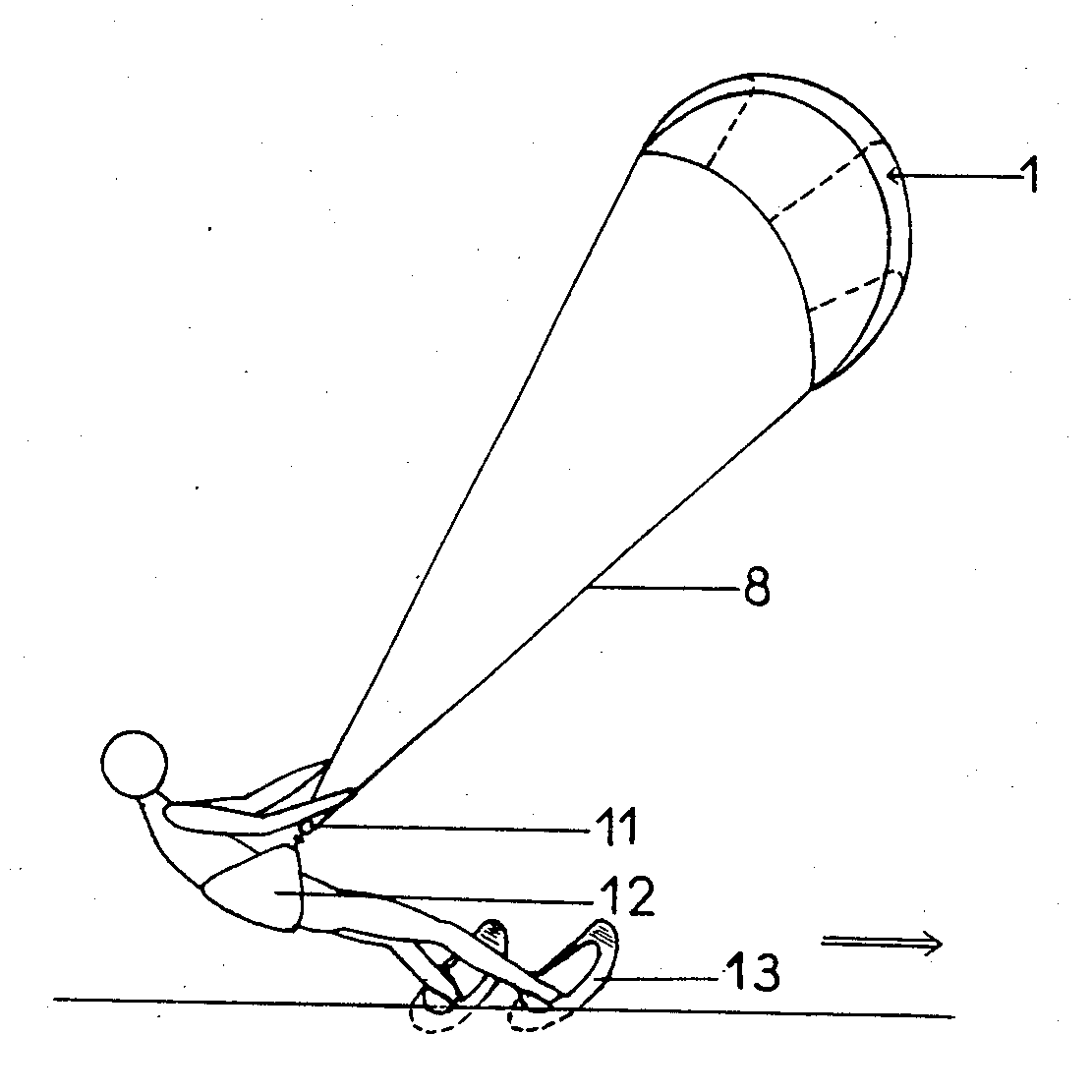Airborne Wind Energy
History of kite applications
Roland Schmehl
12 September 2025
Outline
- Early history
- Middle ages
- Enlightenment
- Golden Age of Kites
- Aerial photography
- Meteorology
- Precursor for powered flight
- Rediscovery for power generation
- Rediscovery for sports
- Airborne wind energy
- Makani
- References
Learning objectives
- Understand for what purposes and how kites were used in the past
- Assess the technical advancements during the Golden Age of Kites
- Develop an overview of the AWE sector and understand what the different academic and industry players are working on
- Identify differences and similarities between past and present use of kites
Early history
Simon Christen/Flickr
Use of kites in the past
Religious: to offer up wishes to the gods of weather and crop fertility at the time of spring planting or at fall harvest; or to just appease the spirit world.
Utilitarian: to carry fishing line and hook out over the water in atolls, thus providing a means of catching fish in somewhat remote water from where the fisherman stood.
Cultural: to demonstrate artistically the symbols of a region or nation in the sky.
Military: to visually signal other troops, scatter messages over the enemy, measure distances, training targets, and as kite technology improved to lift observers over military areas.
Origin of kites
The precise origin of the kite is obscure, however scholars believe it was developed either in China, Malasia, Indonesia or the South Pacific Islands (Polynesia).
A possible but controversial early finding is the kite painting in an Indonesian cave:
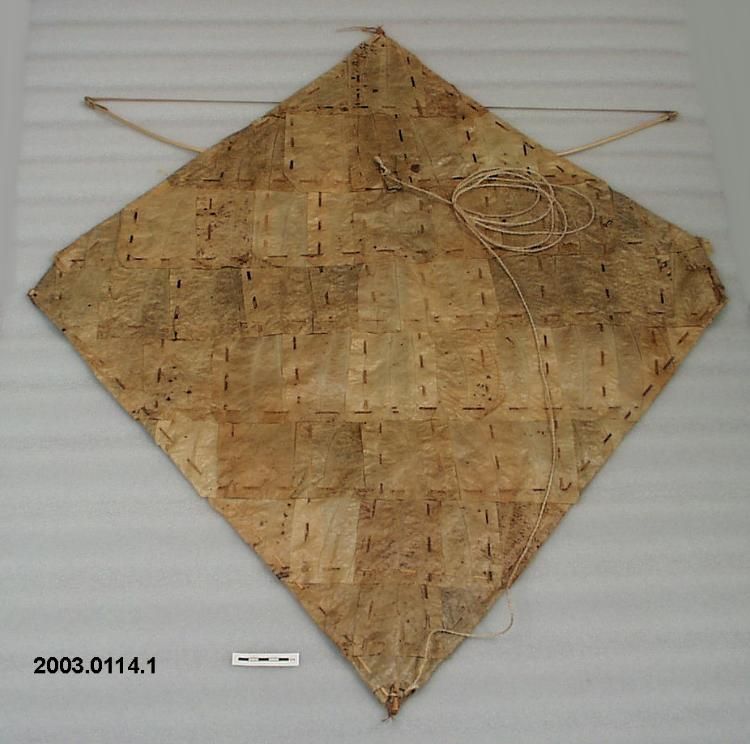
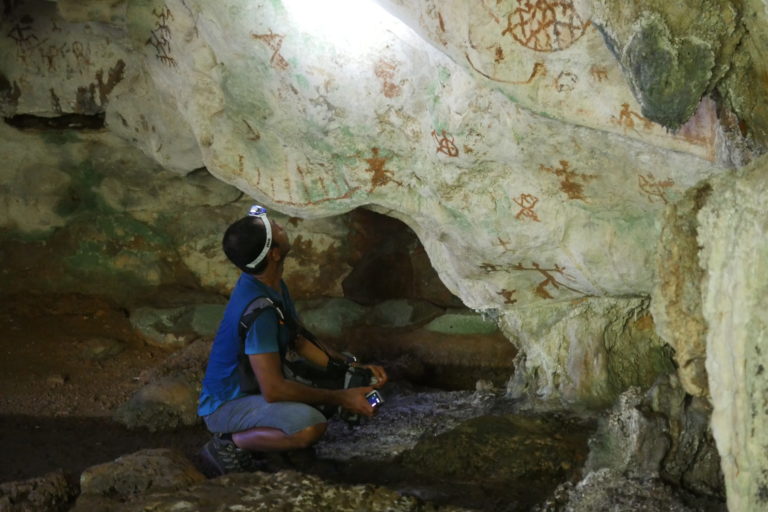
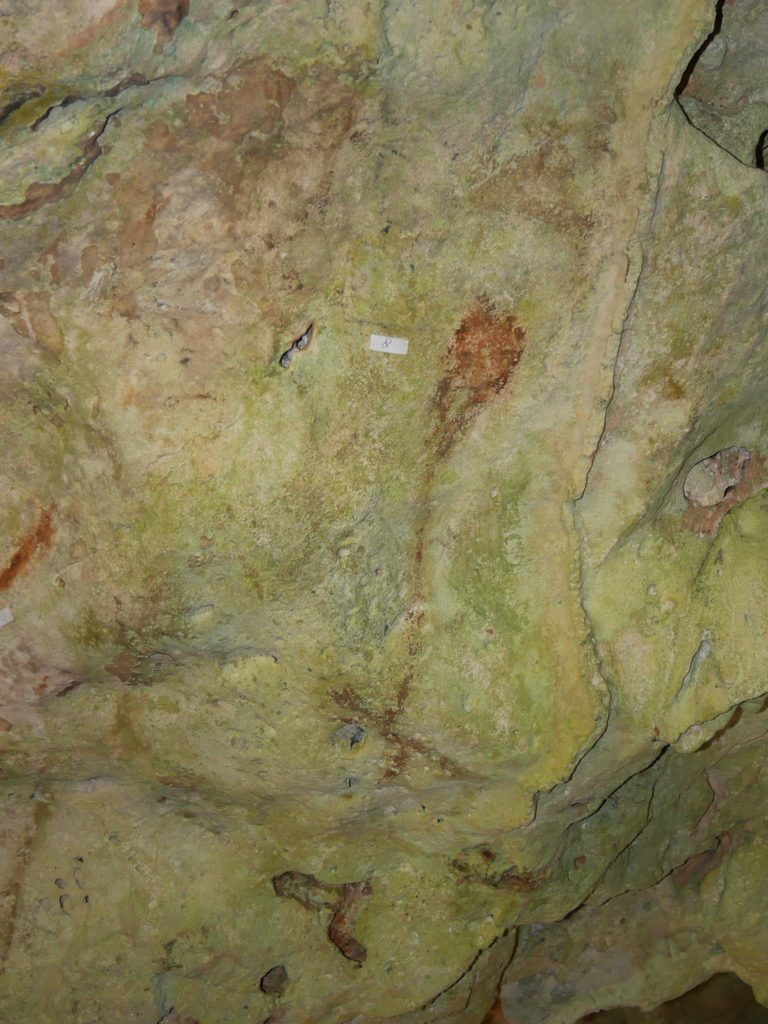
Exhibit: Canada Aviation and Space Museum, Cave paintings: Tari Travel
Early use of kites
- The fishing peoples of the South Sea islands used kites for fishing by attaching bait to the tail of the kite and using a net to catch the fish. A practice that continues in the Solomon Islands.
- Around 1200 AD, Polynesian fishermen were using kites to pull their canoes and can thus be credited as the first power kiters.
- On the Polynesian Islands a kite represented the god Tane, as well as the god Rongo who was the patron saint of the arts, kites, and kite flying. Sometimes, the kites represented the gods themselves. Kite flying was considered a sacred ritual.
- Polynesian folklore records many incidents where kites have been a means of making contact with the heavens. Kites often symbolized gods or have been the toys of the gods. In many cases, Polynesian kites were associated and constructed in the configuration of the wig birds. In early times, turtles, human figures, and abstract shapes were also known.
- The Maori in what is now known as New Zealand believed that birds could carry messages between humans and gods. The Maori god Rehua is depicted as a bird, and was thought to be the ancestor of all kites.
Polynesian fishing kites
Materials:
- Wood, rushes, feathers, and shells, which produced a rattle in flight.
- Thin strands of vine or braided fibers for flying/tethering line.
- A native bark cloth (tapa), leaves, and braided reeds were used for sail material.
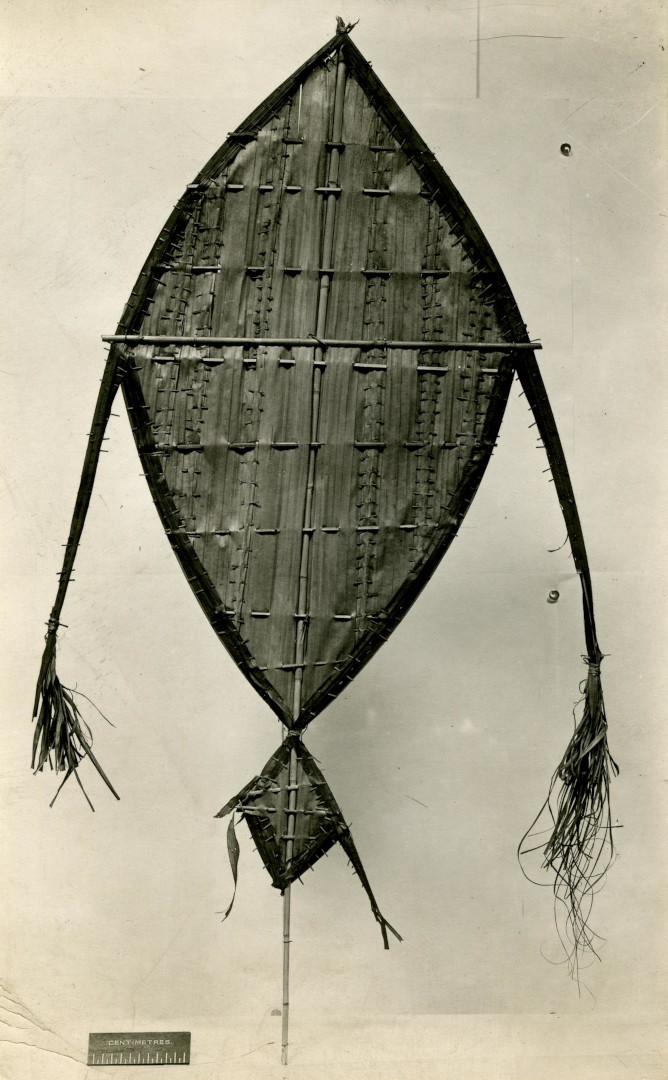
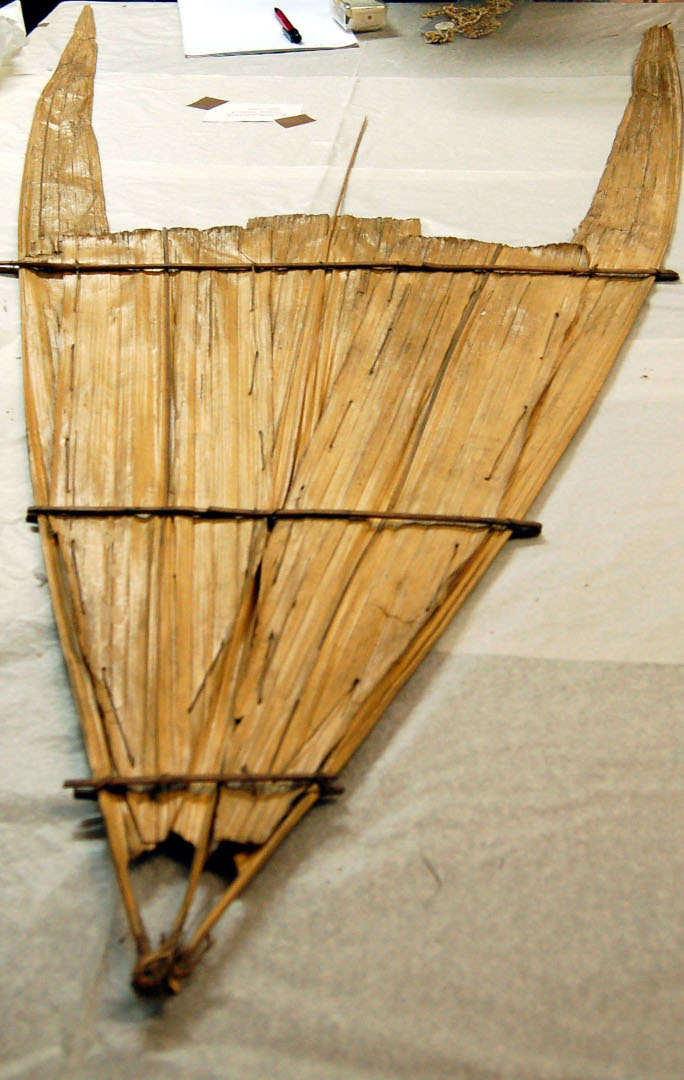
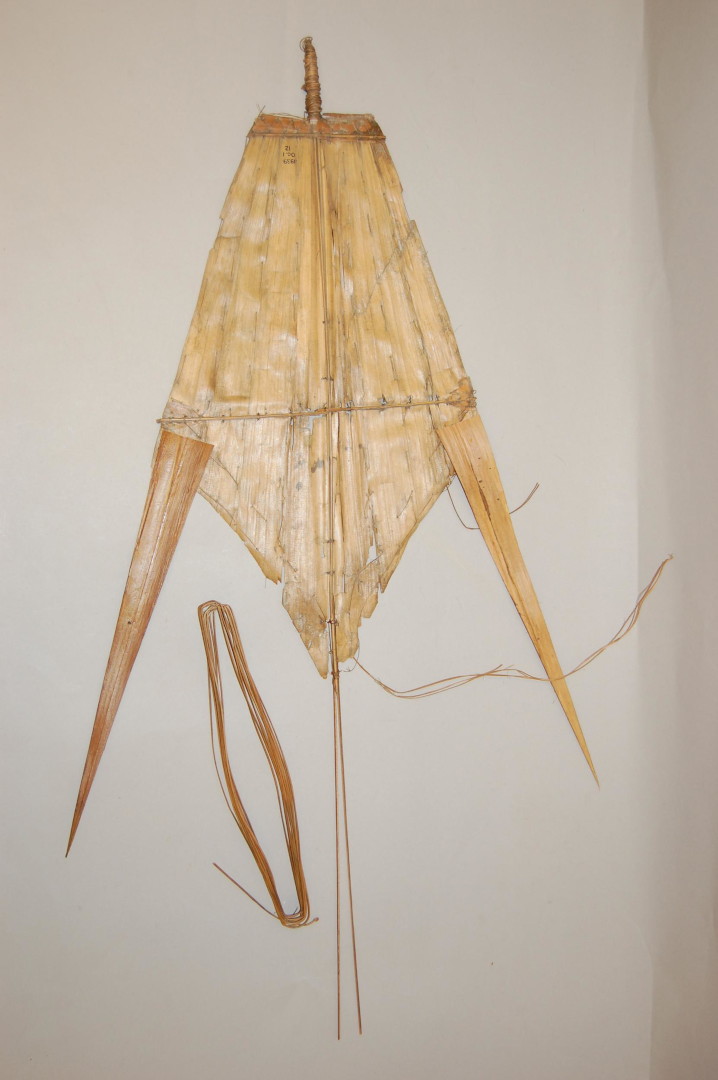

Polynesian kite fishing
Ternate island in 1600 illustrated by Dutch expedition.
Kite fishing in Papua New Guinea
Kite-fishing off Pitilu (Admiralty Islands) in 1908.
H. Vogel, Hamburg Südsee Expedition
Maori kites
Collected in 1843 in the Bay of Plenty on the North
of the Island of Aotearoa, New Zealand, this kite was
made within the tradition of kite flying for spiritual
purposes.
Chinese kites
Approx. 502-549 BC: During the time of LiangwuDi Emperor, a kite was used with limited success to send messages.
Approx. 468-376 BC: Historical records mention the famous Chinese philosopher Mo-tse (Mo Ti in some texts) as the first to build a kite. Living near Mt. Lu, in the area of Qingzhou, Shandong province (near present day Weifang China), Mo-tse carefully carved a bird (a ‘sparrow hawk’ or eagle) over a period of three years. Once satisfied that it was as much like a bird as he could make it, he flew it for only a single day. The exactChinese_traditional_kite details of its flight are not recorded, but there is conclusive, written reference to this event in Chinese history.
Approx. 200 BC: In the Han Dynasty, General Han Xin used a kite as a tool to determine how far his army would have to dig to get under the castle wall.
After the invention of paper AD 105: Kite building and flying became a popular pastime.
Chinese kites
Materials:
- Bamboo or similarly strong reed like branches for framing structure. Thin strands of vine or braided fibers for flying/tethering line.
- Woven cloth and later paper, were commonly used for sail material.

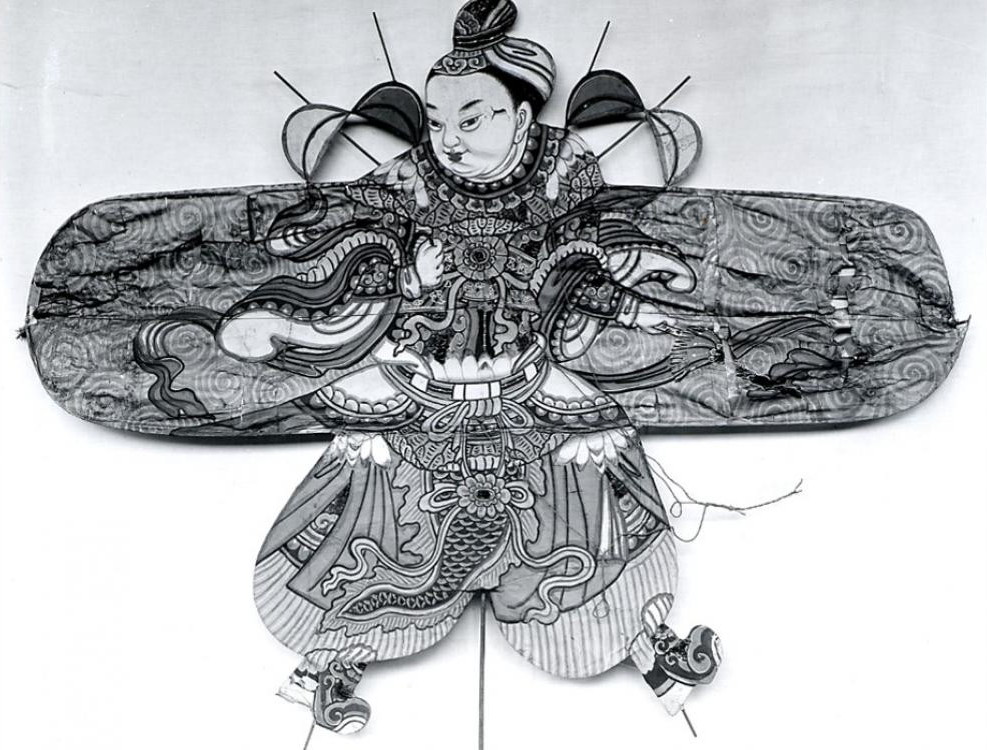
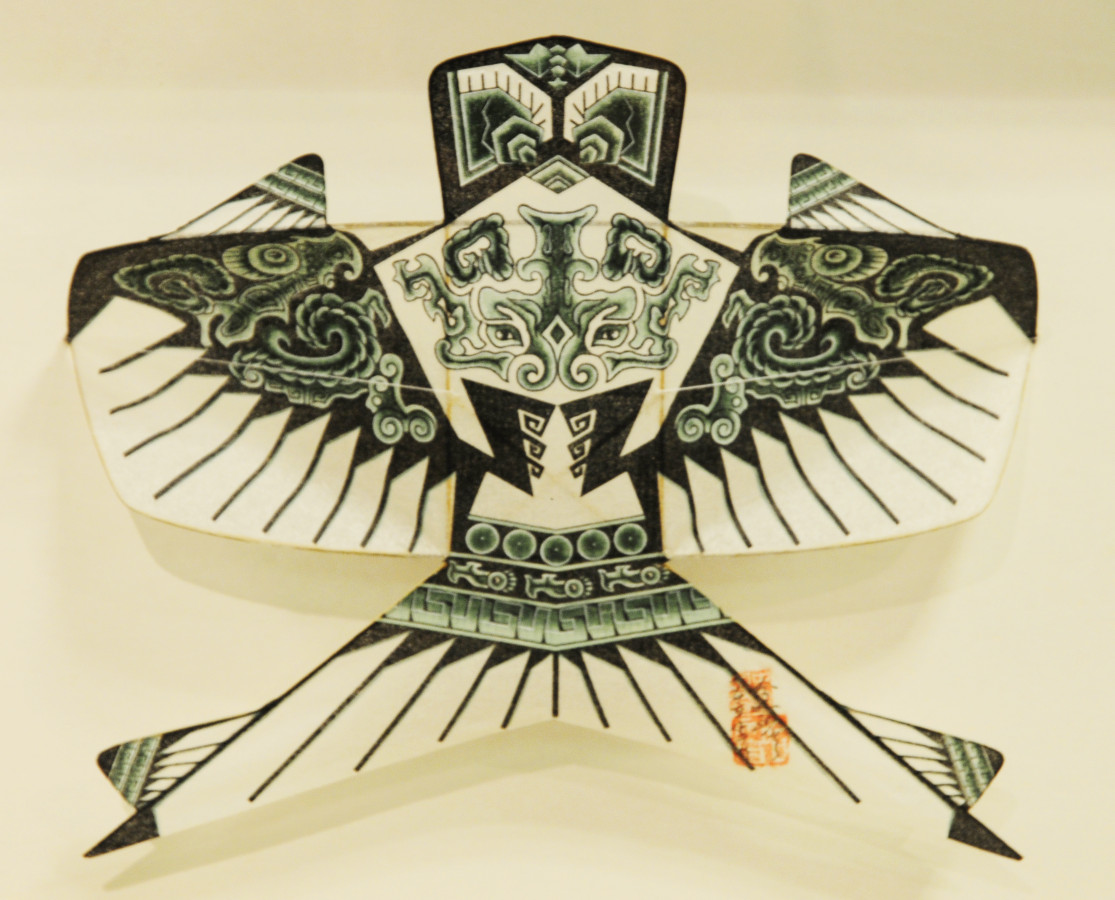
Left: Metropolitan Museum of Art, center: Smithsonian Museum, right: PBS Learning Media
Further reading
Nora K. Chadwick: “The Kite: A Study in Polynesian Tradition”. The Journal of the Royal Anthropological Institute of Great Britain and Ireland, Vol. 61, pp. 455-491, 1931. https://doi.org/10.2307/2843932
Stefan Dietrich: “Flying a kite and catching fish in the Ternate panorama of 1600”. The Journal of the Hakluyt Society, August 2012. https://www.hakluyt.com/downloadable_files/Journal/Ternate_panorama.pdf
George Webster: “The Invention of the Kite”. The Kiteflier, Issue 98, 2004.
http://thekitesociety.org.uk/PDF/Invention%20Kites.pdf
Middle ages
Arrival of the kite in Europe

- By the 13th century, kite flying had spread by traders from
China
to Korea and across Asia to India and the Middle East. Each region
had developed a distinctive style of kite and cultural purpose for
flying them.
Mosaic of Marco Polo displayed in the Palazzo Doria-Tursi, in Genoa, Italy (1867).
- The Greek already knew kites around the 4th century BC.
- In the late 13th century, European explorer, Marco
Polo, describes
in his book from 1295 kites and their man-lifting capabilities after seeing Chinese merchants using kites to determine whether a voyage would be prosperous or not. - Kite flying spread throughout Europe between 14th and 15th centuries with mentions by Vasco da Gama, Giovanni Della Porta, and William Shakespeare.
- Sailors also brought kites back from Japan and Malaysia in the 16th and 17th centuries. Kites were regarded as curiosities at first and had little impact on European culture.
Use for warfare
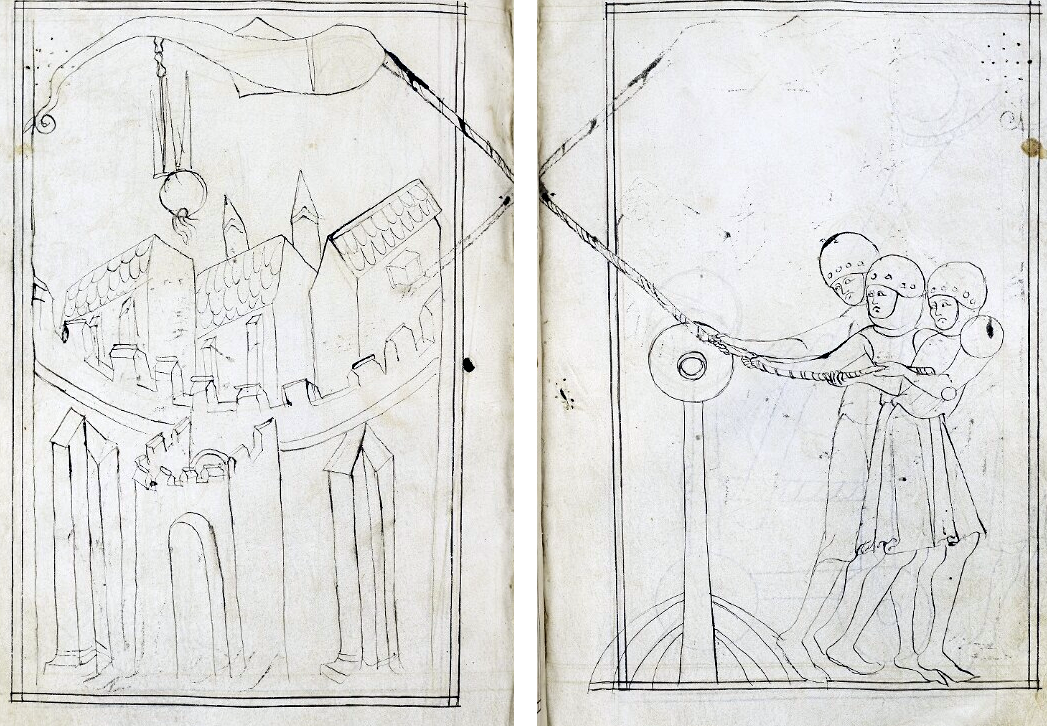
by Walter de Milemete (1326)
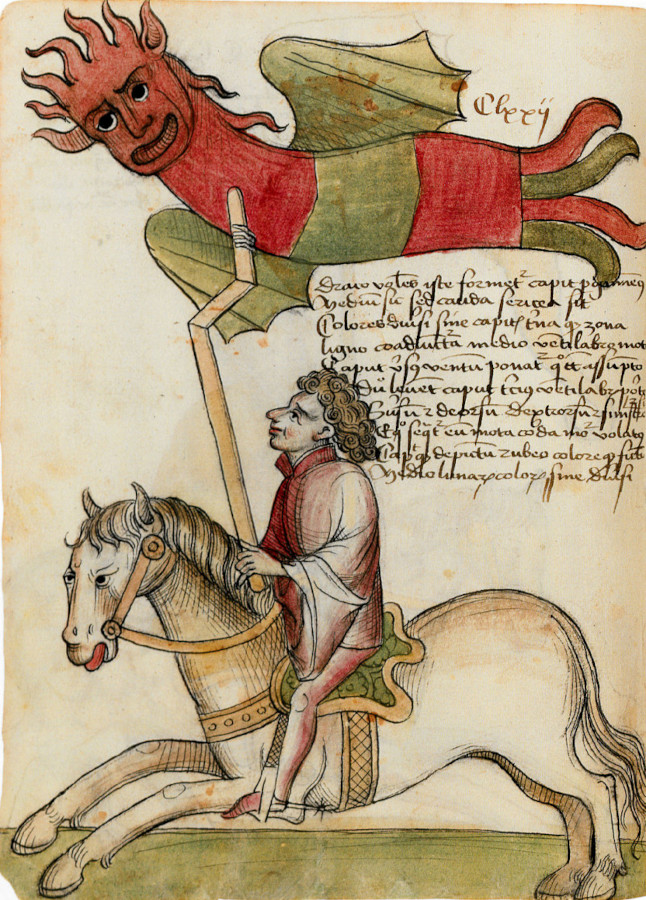
by Konrad Kyeser (~1405)
Renaissance of 15th & 16th centuries
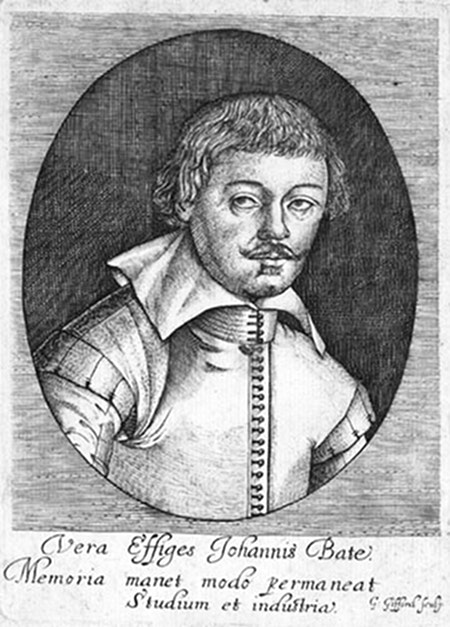
- Period in European history marking the transition from the
Middle Ages to modernity.
- A spirit of initiative and invention lead to
significant advances
in mechanics, chemistry and metallurgy, astronomy and
surveying, the art of navigation, and the measurement of time. - The Mysteries of
Nature and Art was written by John Bate in
1634 as a practical guide for amateur scientific experiments. - It inspired Isaac Newton during his younger years, in particular the section on fire Drakes, kites with firecrackers tied to their tails.
- It contains one of the earliest depictions of fireworks and their preparation to be detailed in the English language, in a similar manner to the preceding De la pirotechnia
The Mysteries of Nature and Art
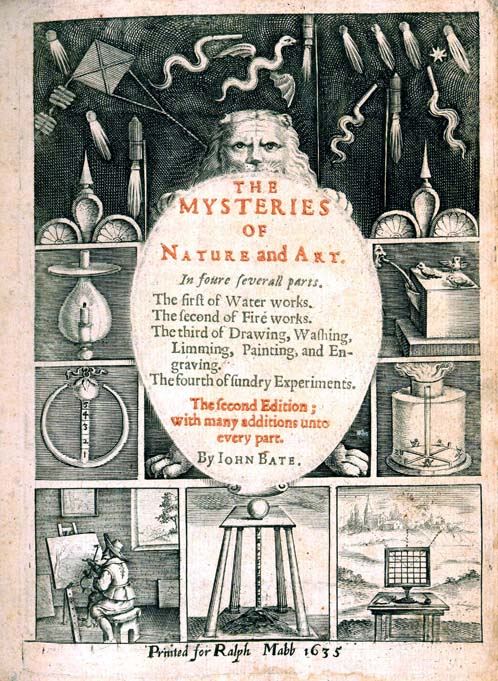
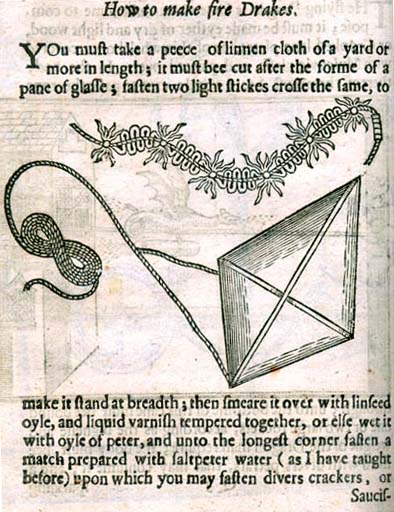
Further reading
- Peter Konieczny: “The History of Flying in the Middle Ages”. https://www.medievalists.net/2019/06/history-flying-middle-ages/
Enlightenment
Scientific and technical explorations (1750–1860)
Rainer Knäpper, Free Art License
Meteorology
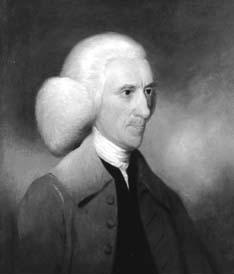
Hunterian Art Gallery, University of Glasgow.
- First recorded weather experiments with kites were performed
in 1749 by two University of Glasgow students, Alexander Wilson
and Thomas Melville.
- Their interest was the possible temperature
variation in the
atmosphere and at the time, kites were the only means to access
higher altitudes. - The scientists built six paper kites, each carrying a small thermometer protected by layers of cloth.
- Each payload had a slow burning fuse and a white ribbon attached.
- The fuse allowed a timed separation of the payload from the kite.
- The white ribbons decelerated the falling payload and signaled to the scientists.
- This experiment was the first recorded attempt to collect scientific data with kites and to use a train of kites.
Electricity

Smithsonian’s National Portrait Gallery
- Benjamin
Franklin published a proposal for an experiment to
prove that lightning is electricity by flying a kite in a storm that
appeared capable of becoming a lightning storm.
- On 15 June 1752, he may possibly
have conducted his well-known
kite experiment in Philadelphia, successfully extracting sparks
from a cloud. - Franklin described the experiment in the
Pennsylvania Gazette on
19 October 1752, without mentioning that he himself had performed it. - This account was read to the Royal Society on December 21 and printed as such in the Philosophical Transactions.
- Franklin was careful to stand on an insulator, keeping dry under a roof to avoid the danger of electric shock.
Benjamin Franklin
Benjamin Franklin Drawing Electricity from the Sky
is a 1816 painting
by Benjamin West depicting
the American founding father conducting his
kite experiment in 1752 to ascertain the electrical
nature of lighting.
Worlds oldest known kite
- French Pear Top kite from 1773.
- Discovered by a carpenter when lifting the attic floor during the renovation of a building at 127 Breestraat, Leiden, the Netherlands in 1985.
- Paper covering and sticks made of hazel wood.
- 930 mm along the spine, 630 mm wide, in flyable condition.
- Purchased and restored by Peter Lynn.
Restoration of the worlds oldest known kite, by Peter Lynn.
Context (1785)
First Channel crossing by hot-air
balloon by Blanchard and Jeffries.
Engineering

- George
Pocock was a schoolteacher in Bristol experimenting
with
man-lifting kites starting in 1820.
- In 1826 he patented the design of the
Charvolant, a buggy that
was pulled by two kites on a single line of 457–459 m. - Four control lines to the kites,
which were fed out or pulled in by
large spools mounted on the front of the carriage, provided a method of steering. - The driver also had to steer the carriage by means of a T-bar which set the direction of the front wheels.
- The driver also was responsible for the brake, an iron bar mounted on the carriage which dug into the road when the lever was pulled.
- Average travel speed with several passengers was 32 km/h.
- On a joint trip of 182 km, one of the three participating Charvolants sailed past the mail coach, which at the time was the fastest means of passenger transportation.
- Initial successes because technology was circumventing taxation of horse-powered carriages, however, ultimately too complex to survive.
Pocock’s book
G. Pocock: The Aeropleustic
Art or Navigation in
the Air by the use of Kites, or Buoyant Sails.
London: W. Wilson, 1827.
G. Pocock, D. Cox, R. Gilbert: A treatise on
the
æropleustic art, or, Navigation in the air : by
means of kites, or buoyant sails. London:
Longman, Brown, and Company, 1851.
Also in:
Special Collections: Book of
the Month: The
Aeropleustic Art or Navigation in the Air by the
use of Kites, or Buoyant Sails. University of
Glasgow. March 2001.
Pocock’s charvolant
George Pocock: The Aeropleustic Art or Navigation in the Air by the use of Kites, or Buoyant Sails
Further reading
- M. Robinson: ” Meteorological Kites – Scientific Kites of the
Industrial Revolution”.
http://www.kitehistory.com/Miscellaneous/meteorological_kites.htm - Peter Lynn: “The world’s oldest known kite”. Kiteboarding, 3 July
2017.
https://www.surfertoday.com/kiteboarding/the-worlds-oldest-known-kite
Golden Age of Kites
Kites at the dawn of aviation, from 1860
until around 1910 (Webster
2003).
Werner Schmidt/wetterdrachen.de
Technical and scientific applications
In the second half of the 19th century, kites where used increasingly for technical and scientific applications.
- Kites were used for continued manned flight experiments.
- First aerial photos were taken from kites in 1882, just 24 years after first aerial photos from a balloon.
- Kites were an important precursor for aircraft, exploring the behavior of the airframe.
- Most importantly was the use for atmospheric research and in the beginning of the 20th century, many meteorological stations in Europe and the US employed kite trains (Schmidt and Anderson 2013).
- Main performance criteria where lift capabilities, stability and reliability.
Evolution of kite designs
Aerial photography
George Lawrence’s “Captive Airship”, a kite train and camera-steadying mechanism (1905).
National Archives and Records Administration
Timeline
Kite aerial photography was pioneered by British meteorologist Douglas Archibald in 18871 and French photographer Arthur Batut in 1888.
Starting in 1882, Archibald experimented with kites for observations of wind speeds at different altitudes using anemometers attached to the tether.
For the aerial photo taken in 1887, Archibald used an explosive charge with a timer.
Aerial photography and manned kite flying weres advanced also by French Marcel Maillot, British Fletcher Baden-Powell, Americans Charles Lamson, William Abner Eddy, George R. Lawrence, Australian Lawrence Hargrave and French Captain Saconney.
Flight stability is the most important requirement for aerial photography kites. Generally, single lined kites are used as they allow very long line lengths and need less intervention from the flyer than steerable designs.
1Although disputed in some literature sources because of an apparent lack of photographic proof.
Aerial photography

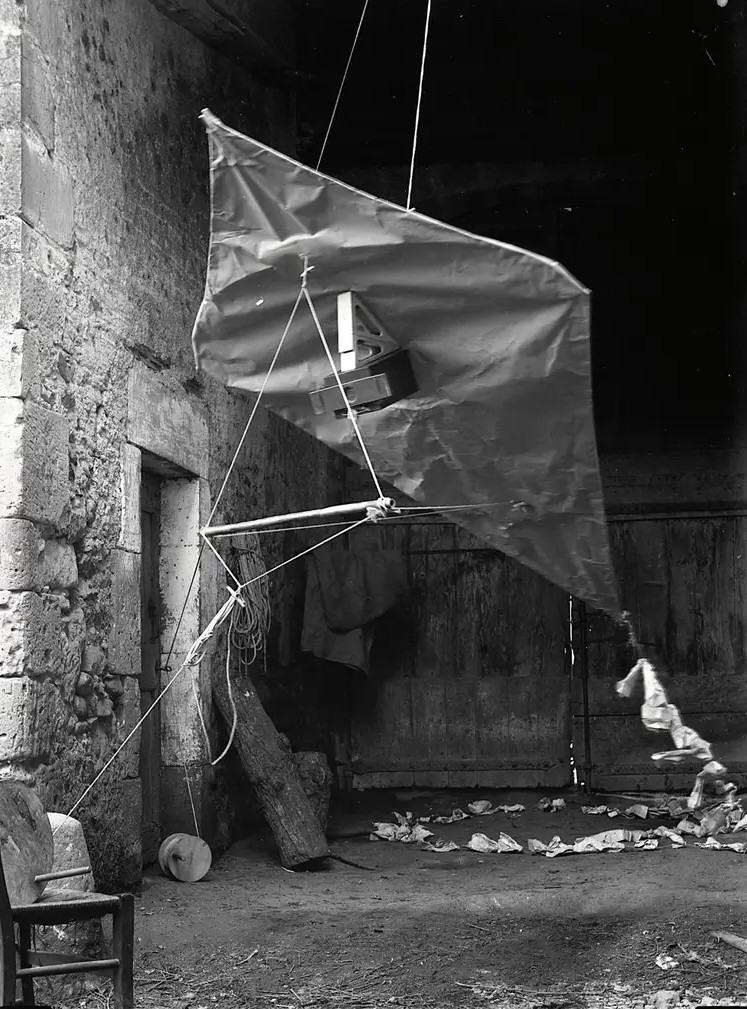

Photos: Collection l’espace photographique Arthur Batut / Archives départementales du Tarn
Labruguière (1889)
Arthur Batut, The town of Labruguière, southern France (1889).
Collection l’espace photographique Arthur Batut / Archives départementales du Tarn
Lawrence kites
Kite train (1905).
National Archives and Records Administration
San Francisco earthquake (1906)
George R. Lawrence: San Francisco in ruins from the kite, 600 meters above San Francisco Bay, overlooking the waterfront (1906).
Library Of Congress
San Francisco earthquake (1906)
Library of Congress
Reconnaissance
French soldiers and kite aerial camera.
Bowed diamond kite (1891)

- William A.
Eddy was a journalist from New Jersey who
investigated how to lift meteorological and photographic
equipment reliably with kites.
- Standard diamond kites used a tail
for improved flight
stability, which was problematic for chaining several kites
to reach higher altitudes. - Inspired by the bowed kite from Java, the Malay
kite, which
was stable without a tail, he developed the bowed diamond
kite. - In 1892, he was invited to the Blue Hill Observatory near Boston (founded 1885) to demonstrate his new lifting technology, which subsequently was adopted.
- The scientific significance of his patented design was short-lived, due to the advent of Lawrence Hargrave’s rectangular box kites.
- Nevertheless, in 1910, a train of ten Eddy kites reached an altitude of 7128 m and set a height record for several years.
Blue Hill Observatory (1897)
Werner Schmidt/wetterdrachen.de
Box kite (1893)
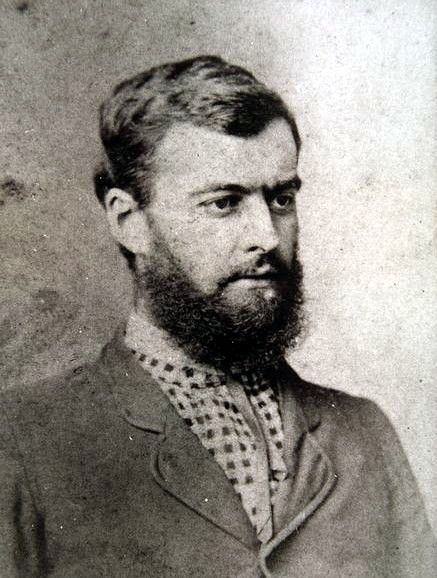
- Lawrence
Hargrave was a British-born Australian engineer,
explorer, astronomer, inventor and aeronautical pioneer.
- Since 1872 he worked at the Sydney Observatory as astronomer.
- Hargrave was a passionate believer in free
communication in
the scientific community, refusing to patent his inventions. - Following a period of extensive experimentation, he
converged
on the box kite design, which appeared him to be the perfect
flying device for human flight. - Hargrave’s box kite was illustrated internationally in subsequent years and is considered a critical link in the development of the European airplane.
- Essentially, the box kite design doubled the wing surface area and by that also the lift, while providing excellent structural stability.
- The cellular structure with vertical wing sections was inherently stable which was an important goal for early aeronautical engineers.
Man-lifting demonstration
Lawrence Hargrave demonstrating his man-lifting kites at Stanwell Park
Man-lifting kite train (1894)
Power House Museum, Sydney.
Prue Mason/pruemason.wordpress.com
Lawrence Hargrave (1910)
Lawrence Hargrave working on a box kite at Point Piper, Sydney, about 1910
Man-lifting kite train (1901)
Kite train by Samuel Franklin Cody in the UK.
Man-lifting kite train (1930)
Leslie Jones (1886-1967), Man-kite at Brockton Fair (1930).
Cody War Kite (1901)

- Samuel
Franklin Cody was a US Wild West showman and
early pioneer of manned flight.
- He was also the first man to fly an aeroplane built
in Britain,
on 16 October 1908. - He is most famous for his work on the large kites
known as
Cody War-Kites, that were used by the British before World War
I as a smaller alternative to balloons for artillery spotting. - He combined Hargrave’s box kites with flexible
winglets as
a passive depower mechanism and for flight stability. - In 1908, the War Office officially adopted Cody’s kites for the Balloon Companies he had been training.
- He later moved to powered aviation, and died on 7 August 1913 when his latest design, the Cody Floatplane, crashed near Farnborough.
Wikimedia Commons
Cody war kite Mark III
Cody war kite Mark III.
Cody war kite Mark III plan 1
Cody war kite Mark III plan 2
Meteorology
Lindenberg winch house with box kite around 1920.
Marvin Kite (1897)

- Charles Frederick Marvin was an American meteorologist.
- In 1883, he was appointed to the United States Army
Signal
Corps of the United States Army. - In 1891, he was transferred to the
newly created civilian Weather
Bureau, where he became professor of meteorology in 1903. - In 1896 he won a competition with
his article “The Mechanics
and Equilibrium of Kites” which was published one year later in
“Monthly Weather Review”. - From 1897 on his radical redesign of the Hargrave box kite was used at 17 US weather stations.
- While Hargrave’s box kite allowed a degree of twisting along the span, Marvin’s redesign used an entirely rigid box frame.
- The kite was built in tree sizes, a standard version, a smaller one for strong wind, and a larger one for light wind.
Marvin Kite (1897)
Ellendate Station, US Weather Bureau
National Oceanic and Atmospheric Administratio (NOAA)
Diamond kite (1904)
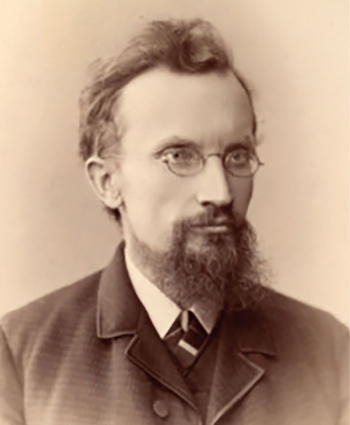
- Wladimir
Köppen was a Russian-German geographer,
meteorologist, climatologist and botanist.
- In 1875, he was appointed as head of the new
Division of Marine
Meteorology at the German naval observatory in Hamburg. - He is considered to be the principal
founder of climatology
and meteorology. - To improve his weather predictions, Köppen started using kites in 1898, first building several Malay kites and a Hargrave box kite.
- In 1903 he established a larger kite station in Groß Borstel, a village outside of Hamburg.
- The facility included a rotatable wooden house, with an engine-powered winch.
- The kites were flown to about 2 to 4 km altitude, measuring air pressure, temperature, humidity, wind speed and direction.
- In 1904 Köppen constructed a box kite with rhomboidal cross section and winglets, which he name diamond kite.
University of Graz Library
Kite station Hamburg-Groß Borstel
Werner Schmidt/wetterdrachen.de
Passive aeroelastic deformation mechanism
Wind gust
increases aerodynamic loading,
which bends aeroelastic
winglets,
by that reducing loading of
kite,
reducing risk of tether rupture.
Lindenberg N-Kite (1900-1905)

- Richard Assmann was a German meteorologist and physician.
- He is considered a co-founder of atmospheric
science, the study
of the Earth’s atmosphere and its various inner-working physical
processes. - In 1900 he founded the
Aeronautical Observatory in Berlin-Tegel,
and from 1905 until 1914 was a first director of the Aeronautical
Observatory Lindenberg. - The Lindenberg N-Kite (Normaldrachen) is the result of a longer series of tests, which was already started at the Aeronautical Observatory in Berlin-Tegel.
- Starting point for the scientists was the Marvin Kite, which was used by the US Weather Bureau.
- One point of improvement was the simplification of the box frame.
- The kite was built in three sizes, with 4, 6, and 7 horizontal wing surface area.
Lindenberg observatory (1905)
Lindenberg winch house around 1905.
Ullstein bild Dtl.
Lindenberg N-Kite (Normaldrachen)
Werner Schmidt/wetterdrachen.de
Barograph
Research ship Gna (1907-1954)
for atmospheric resarch on lake Constance

Lindenberg S-Kite (Schirmdrachen)
Werner Schmidt/wetterdrachen.de
Lindenberg S-Kite
Lindenberg S-Kite
Lindenberg R-Kite (Regulierdrachen)

- Rudolf
Grund was hired in 1907 as an apprentice by the
Lindenberg Observatory, participating in measurement
campaigns with balloons and kites and eventually became
head of flight operation.
- He is regarded the most important German
kite designer
for meteorological research. - He knew the shortcomings of N- and S-Kites and in 1916 patented a passive depower mechanism for box kites.
- His subsequent redesign, the “Regulierdrachen”, was flown for the first time in 1929.
- The adaptive kite combined the successful inner skeleton of the S-Kite with two innovations: a hinged connection of front and rear cells with an elastic member.
Werner Schmidt/wetterdrachen.de
Passive pitch mechanism (Grund patent 1916)
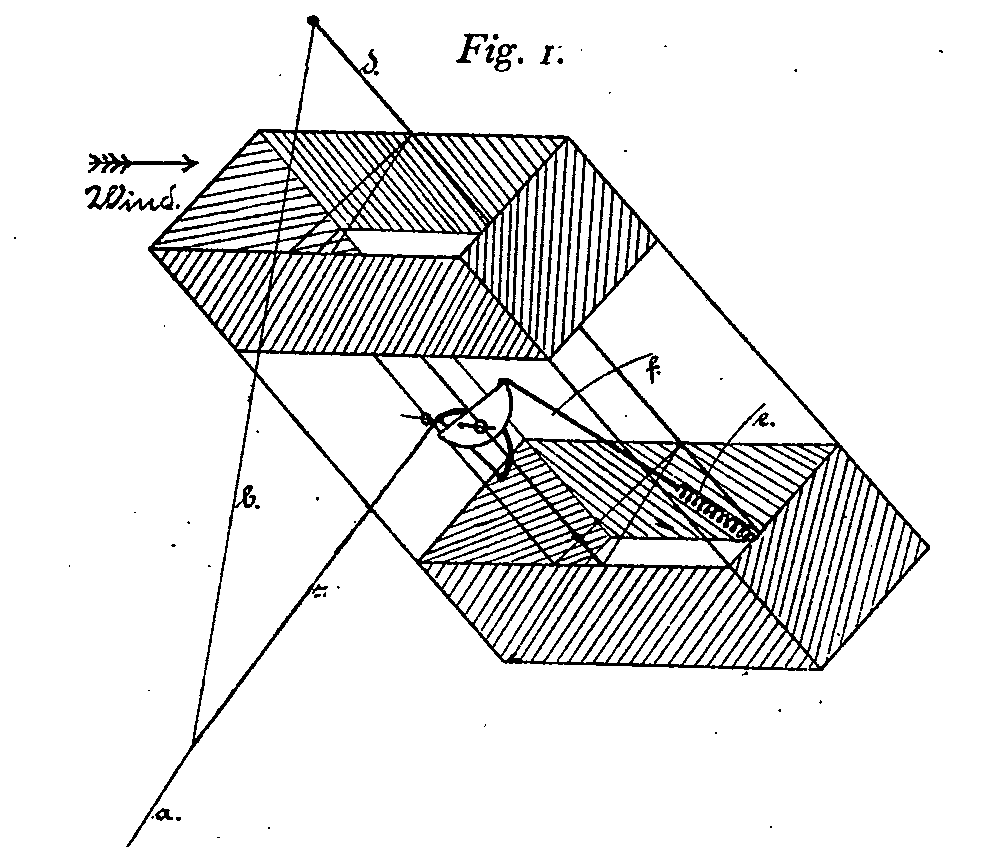
Low wind speed
- High angle of attack
- Traction force maximized

High wind speed
- Low angle of attack
- Traction force limited
Grund (1916)
Passive pitch mechanism (Grund patent 1916)
Lindenberg R-Kite
Grund (1930)
Hinged two-cell kite depower mechanism
Lindenberg R-Kite 1989
Peter and Anne Whitehead
Lindenberg R-Kite
Maiden flight of a restored 32 m2 Lindenberg R-Kite on Fanø in 2009
Werner Schmidt/wetterdrachen.de
Lindenberg R-Kite
Werner Schmidt/wetterdrachen.de
Lindenberg observatory (1930)
- Most advanced observatory using kites
- 50 km SW of Berlin, Germany
- Fully 360° rotatable winch house
- Two flights per day
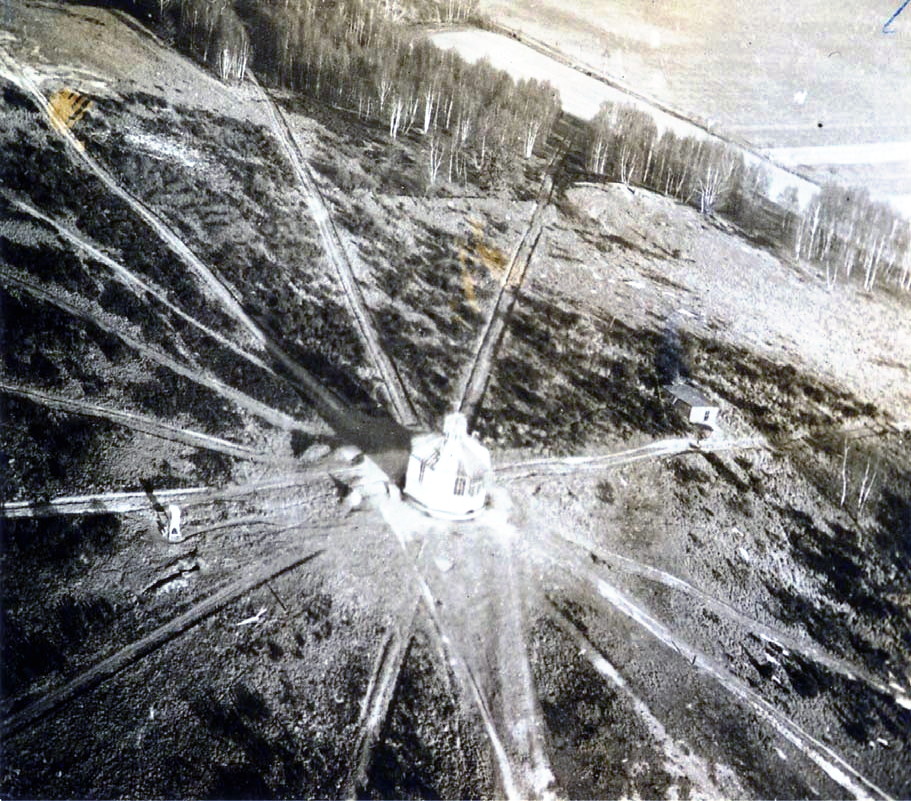
Werner Schmidt/wetterdrachen.de
Altitude world record with kites (1919)
Altitude world record with kites (1919)
- The altitude record was achieved with a train of eight Lindenberg S-Kites, developed by Herrmann Schreck
- The S-Kite showed better flight behavior than
the N-Kite - 15,000 m steel wire, 0.6 to 1.0 mm thick were
deployed - Eight kites with 10, 8 and 5 m2 wing surface
area were used
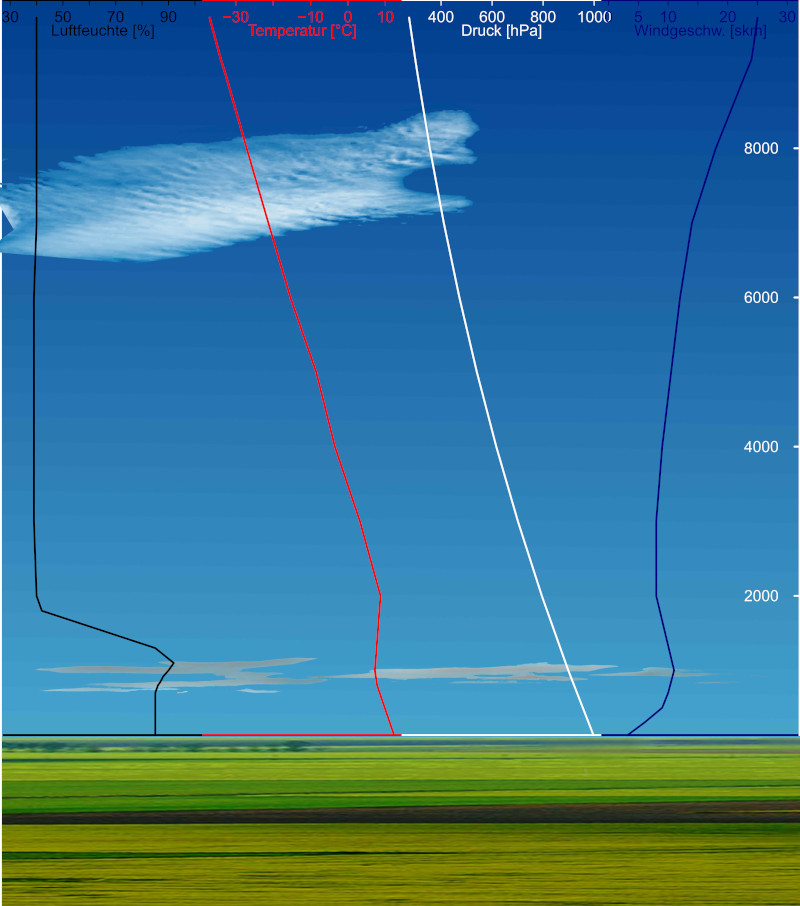
Data recording of altitude world record
Hergesell (1922)
Altitude record celebration (1919)
Werner Schmidt/wetterdrachen.de
Winch house
Photos by Werner Schmidt on 5 October 2000.
Winch house
Winch house
Winch house
Winch house
Winch house
Winch house
Discontinuation of kites for meteorology
- By around 1930, airplanes were considered more efficient for acquiring meteorological data (R. 1931)
- As consequence, kite-based measurements were more and more discontinued
Further reading
Schmidt, W., Anderson, W.: Kites: Pioneers of atmospheric research. In: Ahrens, U., Diehl, M., and Schmehl, R. (eds.) Airborne wind energy. pp. 95–116. Springer, Berlin Heidelberg (2013). doi:10.1007/978-3-642-39965-7_6
Diem, W., Schmidt, W.: Wetterdrachen von Benjamin Franklin bis Rudolf Grund. BoD Verlag, Norderstedt (2010)
Webster, G.: Kite for a purpose (the golden age of kites?). In: The kiteflier. pp. 15–25 (2003). http://www.thekitesociety.org.uk/PDF/Golden%20Years.PDF
Millet, J.B.: Scientific kite flying, with special reference to the Blue Hill experiments. The Century illustrated monthly magazine, Vol. 54, pp. 66-77 (1897).
https://hdl.handle.net/2027/uiug.30112001985784Wille, J.: Colonizing the Free Atmosphere - Wladimir Köppen’s ‘Aerology’, the German Maritime Observatory, and the Emergence of a Trans-Imperial Network of Weather Balloons and Kites, 1873-1906. History of Meteorology, Vol. 8, pp. 95-123 (2017). https://journal.meteohistory.org/index.php/hom/article/view/72
Precursor for powered flight
Library of Congress
Wright brothers first flight, 120 feet in 12 seconds, 10:35 a.m., 17 December 1903; Kitty Hawk, North Carolina.
Wright brothers kites
Library of Congress
- The Wright
brothers were American aviation pioneers
generally credited with inventing, building, and flying
the world’s first successful motor-operated airplane.
In 1899, Wilbur built a biplane kite to test whether
warping the wings would roll the craft right and left.
The kite was controlled from the ground by four cables attached to two sticks.The brothers originally referred to this as wing twisting, but Octave Chanute later dubbed it “wing warping” and the name stuck.
The kite had a small horizontal tail attached to back middle strut. This was the last flying machine built by the Wrights to have a horizontal tail in the back until over a decade later, when the Wright Company began to manufacture the Wright Model B airplane.
1899 Wright Kite
Reproduction
- Biplane kite with 1.5 m wingspan
1899 Wright Kite
Reproduction
- Unbraced between front and rear struts
to allow for wing-warping
1899 Wright Kite
Library of Congress
Wing warping for roll control
Roll
control
Pitch
control
Library of Congress / animation by Clifford Barton
1900 Wright Glider
Lift and drag equation (1900)
The accepted equations for lift and drag were:
\(\begin{align} L & = k S \CL \vaexp{2} \\ D & = k S \CD \vaexp{2} \end{align}\)
where
\(L\) and \(D\) are the lift and drag forces in
pounds
\(k\) is the coefficient of air
pressure (Smeaton
coefficient)1
\(S\) is the total area of lifting
surface in square feet
\(\CL\) and \(\CD\) are the coefficients of lift and drag
(vary with wing shape)
\(\va\) is the apparent wind velocity
in miles per hour
The poor lift of the gliders led the brothers questioning the accuracy of the Smeaton coefficient, 0.005, which had been in use for over 100 years. Also doubting the accuracy of Lilienthal’s lift coefficient they conducted own wind tunnel experiments.
1In modern aerodynamic analysis, the dynamic pressure of the flow around the wing is used to describe the pressure dependence.
1903 Wright Gliders
1903 First powered flight
Further reading
- Smithsonian National Air and Space Museum: Researching the Wright Way. https://airandspace.si.edu/explore/stories/researching-wright-way
- Cherne, J., Culick, F., Zell, P.: The AIAA 1903 wright ’flyer’ project prior to full-scale tests at NASA ames research center. In: 38th aerospace sciences meeting and exhibit, Reno, NV, USA 2000. doi:10.2514/6.2000-511
Rediscovery for power generation
Prototype testing the flying electric generators in Australia in May 1986.
Photo by Bryan Roberts, provided by PJ Shepard
The visionaries
- Aloys van Gries (1935): Wind power machine carried by kites
- Hermann Oberth (1977): Kite power plant
- Miles L. Loyd (1980): Crosswind kite power
- John F. Wellicome (1984): Ship propulsive kites
- Bryan Roberts (1986): Flying electric generators
Tethered flying wind turbine (1935)
- Aloys van Gries headed the department of
aircraft statics at Berlin Adlershof during WW1.

- In 2021, he published a book on aircraft statics.
- In 1935, aged 70, he patented the concept to use kite
trains to lift an onboard wind turbine to higher altitudes.
Oil crisis & renewable energies (1970-80)
Hermann
Oberth (1977):
Kite power station
- Kite-lifted shrouded wind turbines
- Targeting also jet streams
John F. Wellicome (1984)
Ship propulsive kites
- Crosswind maneuvering kite
- Outperforms other solutions
Crosswind kite power (1980)
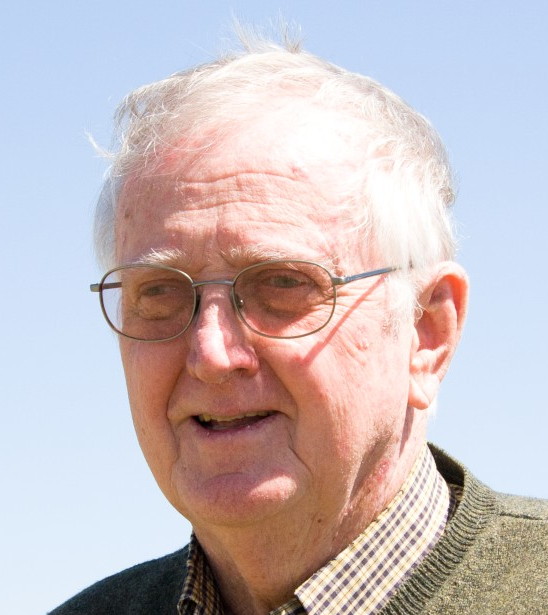
Miles L. Loyd visiting a test of Makani’s Wing 4 prototype in 2010.
- Miles L. Loyd was an engineer working at the
Lawrence
Livermore National Laboratory
- Over 40 years ago, Loyd published the paper
Crosswind
Kite Power one of the first theoretical works about using
kites for harnessing wind energy. - Although highly idealized, the analytical
model remains
an important foundation for follow-up models, where many of
the assumptions have been relaxed for higher accuracy. - Patent: US4251040A
Airborne vs ground-based conversion
Airborne energy conversion:
- Flying wing \(\leadsto\) shaft power
- Shaft power \(\leadsto\) electricity (\(\omega\uparrow\))
- Electricity \(\leadsto\) conductive tether
Ground-based energy conversion:
- Flying wing \(\leadsto\) traction force
- Traction force \(\leadsto\) shaft power (\(\omega\downarrow\))
- Shaft power \(\leadsto\) electricity
Regular vs crosswind kite
Loyd’s hardware
Loyd’s testflights
Rediscovery for sports
Wissant, France, 2020
The pioneers
- Gijsbertus Adrianus Panhuise (1977): Patent on kitesurfing, no commercial interest
- Dieter Strasilla (~1980): Developed parachute- and kite-skiing systems
- Bruno and Dominique Legaignoux (1984): Patented an inflatable kite design
Inflatable surf kites
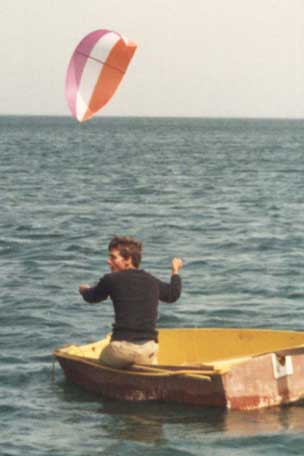
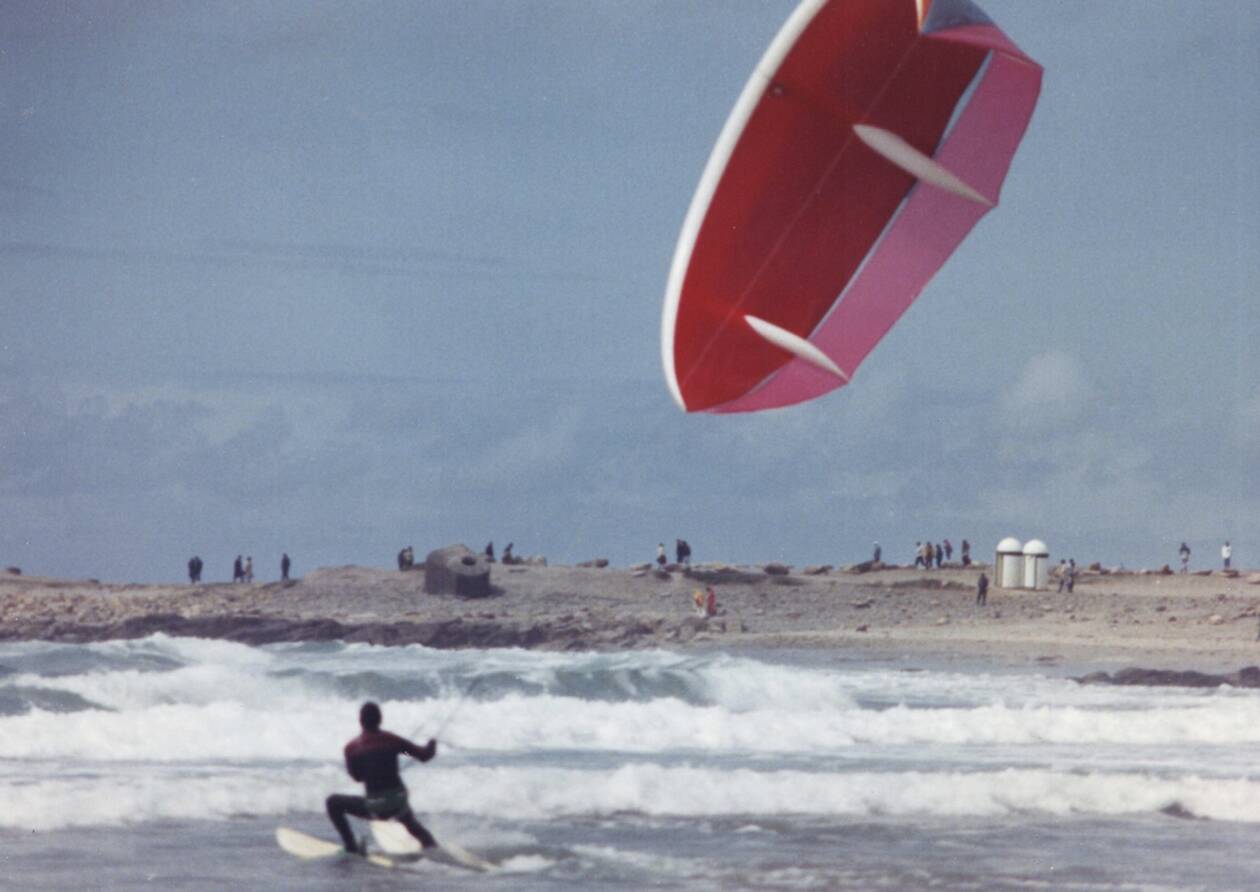
Kite surfing now
- 2022: kite market was valued at approximately US$ 1.59 billion
- 2023: projected expansion to US$ 2.20 billion
Further reading
- Peter Campbell & Stuart Webb: History of kitesurfing. https://kitesurfing-handbook.peterskiteboarding.com/history-of-kitesurfing
Airborne wind energy
Makani climate action (2019)
Andrea Dunlap/Makani
Three phases of development
2000-2010: pioneering first phase of renewed interest with isolated R&D and proof of concept demonstrations
2010-2020: second phase of increasingly networked R&D leading to the formation of the industry sector and pre-commercial technology demonstrations
Since 2020: third phase of first pre-commercial deployments in relevant environments
Technology emergence from 2000 to 2020
Wubbo Ockels
Stanford 2010
Leuven 2011
Berlin 2013
Delft 2015
Freiburg 2017
Glasgow 2019
Milan 2022
Madrid 2024
Textbook 2013
- First textbook on AWE
- Published 2013 with Springer
- 35 peer-reviewed chapters
- 611 pages
- 155k Accesses, 189 Citations as of September 2025
High-impact publication
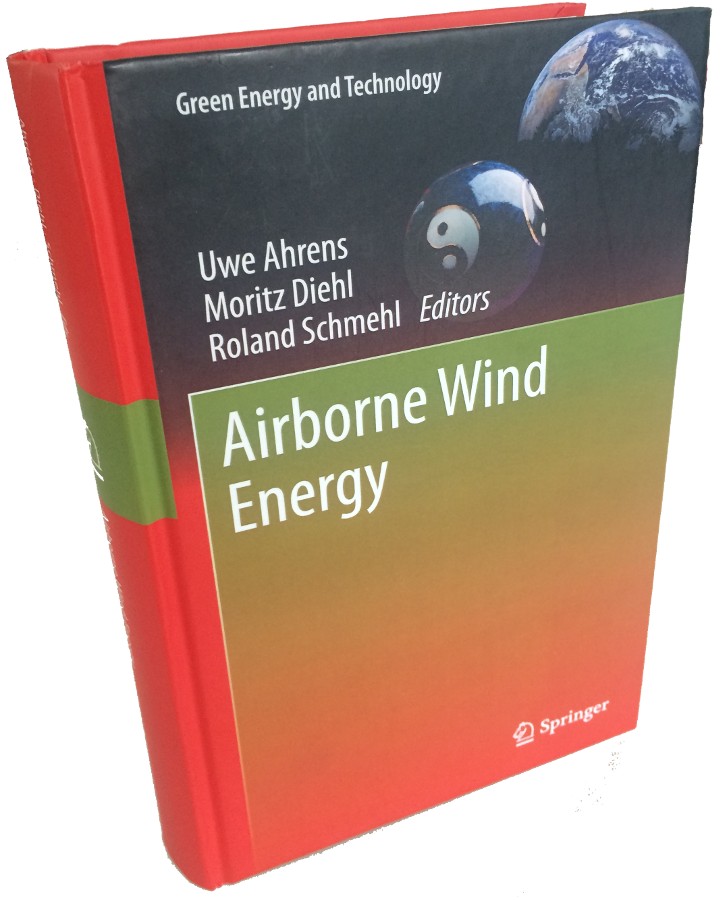
Textbook 2018
- Second textbook on AWE
- Published 2018 with Springer
- 30 peer-reviewed chapters
- 752 pages
- 70k Accesses, 90 Citations as of September 2025
Second high-impact publication

Journal Special Issue 2023
- Airborne Wind Energy Systems
- Edited by Christoph M. Hackl and Roland Schmehl
- Open access journal Energies
- 23 contributed articles
IEA Wind Task 48
Kitepower on PostNL Innovation Stamp (2021)
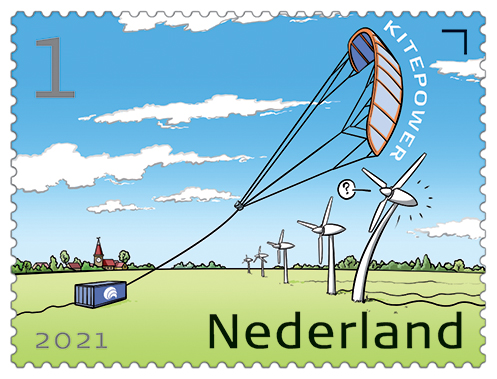
Makani
| Years active | 2006-2020 |
| Headquarters | Alameda, CA, USA |
| Type | Subsidiary company of Google (2013-2020) |
| Conversion concept | Onboard wind turbines |
| Kite design | Fixed wing with single fuselage & tailplane |
| Kite control | Aerodynamic control surfaces & onboard turbines |
| Ground connection | Single tether with two-line bridle |
| Launching & landing | VTOL |
Makani 2007
Makani 2007
Makani 2007
Makani 2008
Miles Loyd visit
Visit of Makani test in 2010 (archive.org)
Wing 7
The 20 kW energy kite in 2013 (Schmehl 2015).
M600
M600
Flight modes
Hardham (2012)
FAA testing
Echeverri (2020)
M600 test site on Mauii
Still visible on Google Maps satellite footage.
M600 testing on Mauii
M600 testing on Mauii
Comparison wind turbine
Offshore testing
Karmøy, Norway (2019)
Offshore testing
Offshore testing
Offshore testing
Offshore testing
Offshore testing
Offshore testing
Offshore testing
Offshore testing
Offshore testing
Offshore testing
Offshore testing
Offshore testing
Offshore testing
End of flight
Offshore testing
Modeling Makani’s Kite/Buoy Interaction for Deep Water Offshore
Controls engineer Joel describes modeling the first offshore energy kite system. One of the most challenging aspects of taking Makani’s energy kite system offshore was predicting how to control the kite flying from a moving base station atop a floating platform. Makani’s flight controller had to be modified to be able to handle the complexity of flying from a floating platform and that required updating a full simulation of the Makani system offshore.
The general development philosophy at Makani was to use simple analytic models for design and then throw in more complex physics into the simulation used for verification. While many approximations were employed in designing controllers, we tried to put all the physical effects we could think of into the simulator. The hope was that this would lead to a more robust system.
27 March 2019. Filmed and edited by Andrea Dunlap.
Tech Topic | 20190327
Oktoberkite
Homsy (2020)
Oktoberkite
Homsy (2020)
Oktoberkite
Homsy (2020)
Makani’s legacy
- Data, media and document archive: Makani Technologies
LLC.
This archive includes a detailed technical report in three parts. - Medium post by Makani’s CEO: A long and windy road
- Feature film: Pulling Power from the Sky: The Story of Makani
